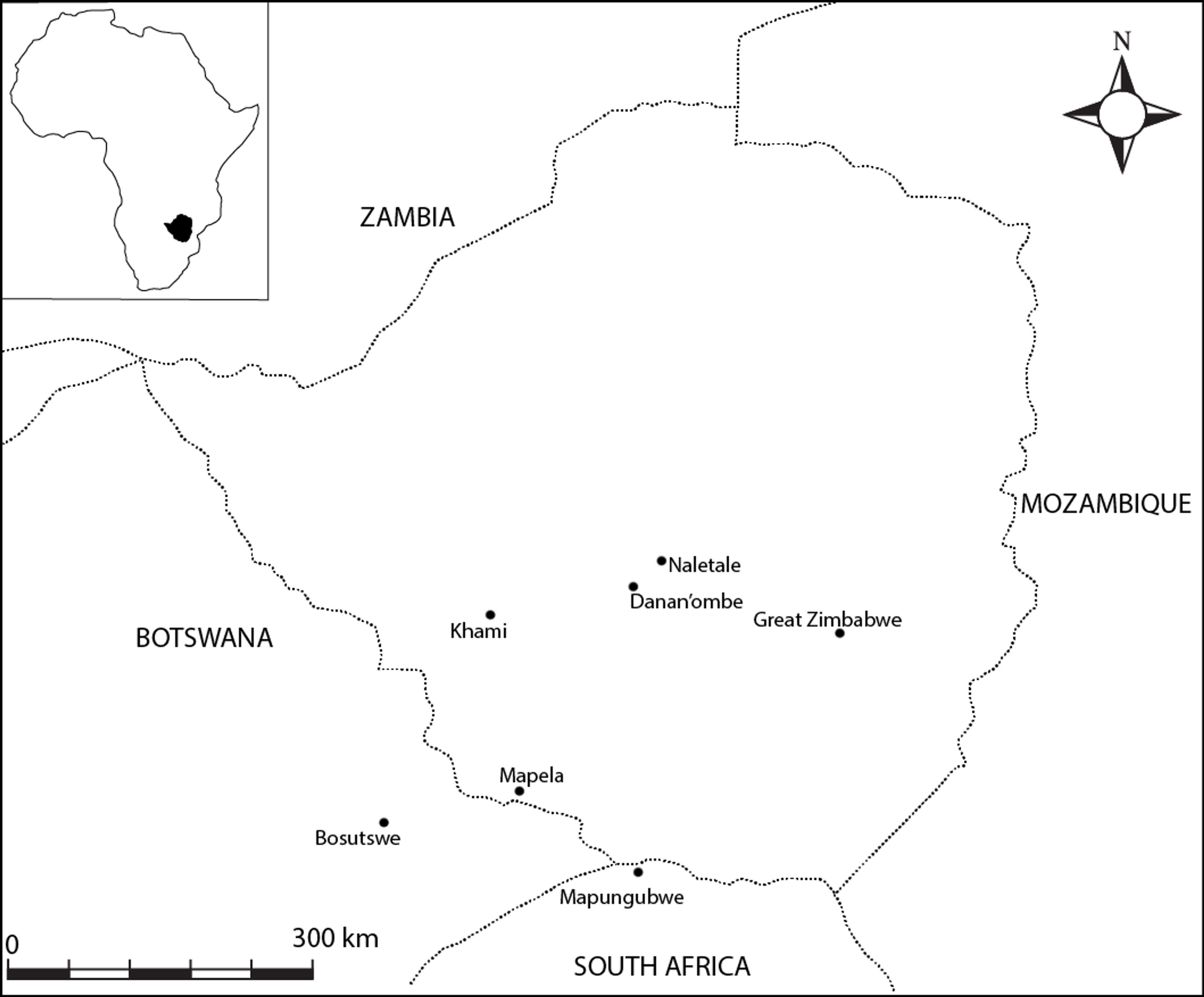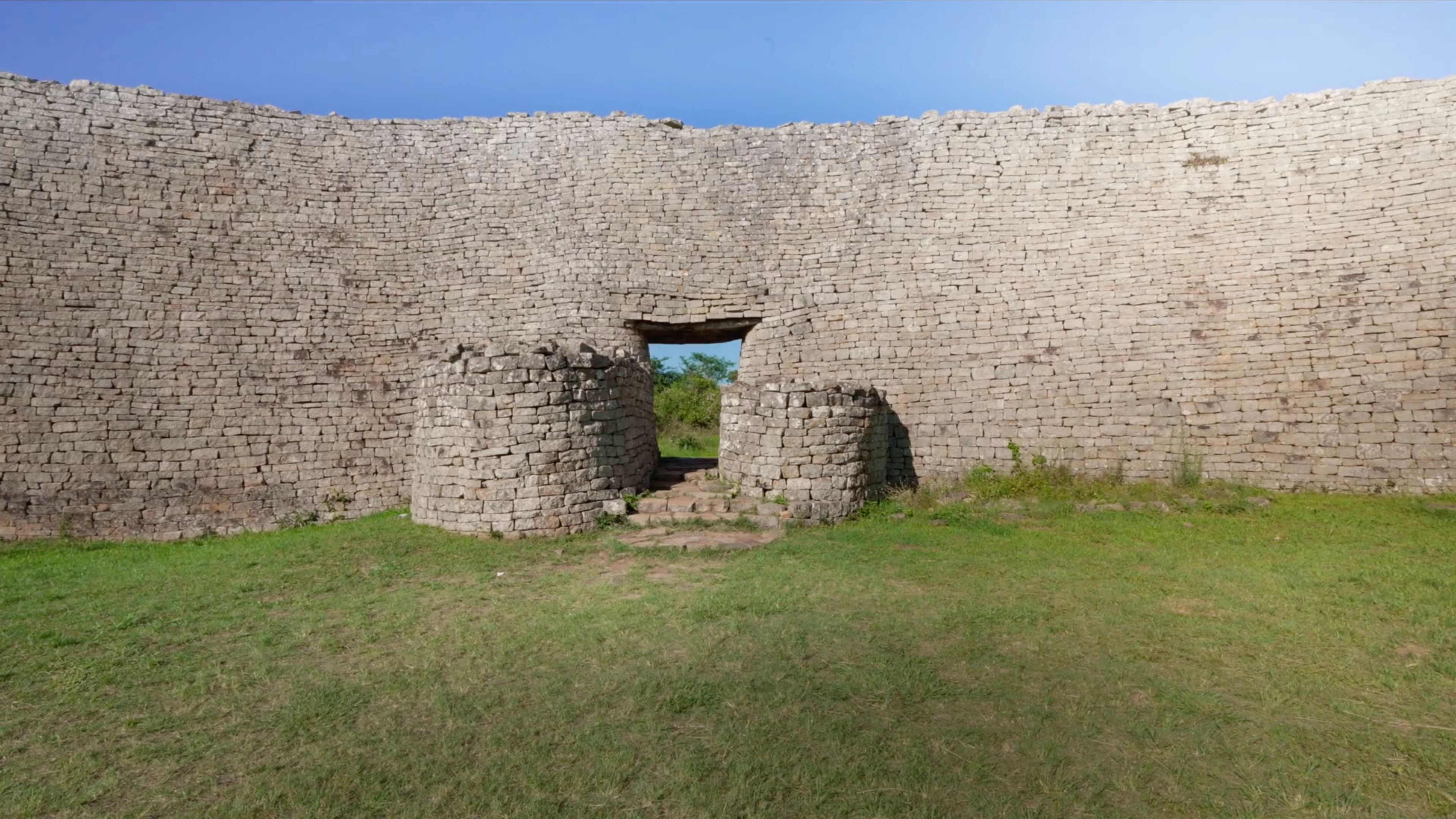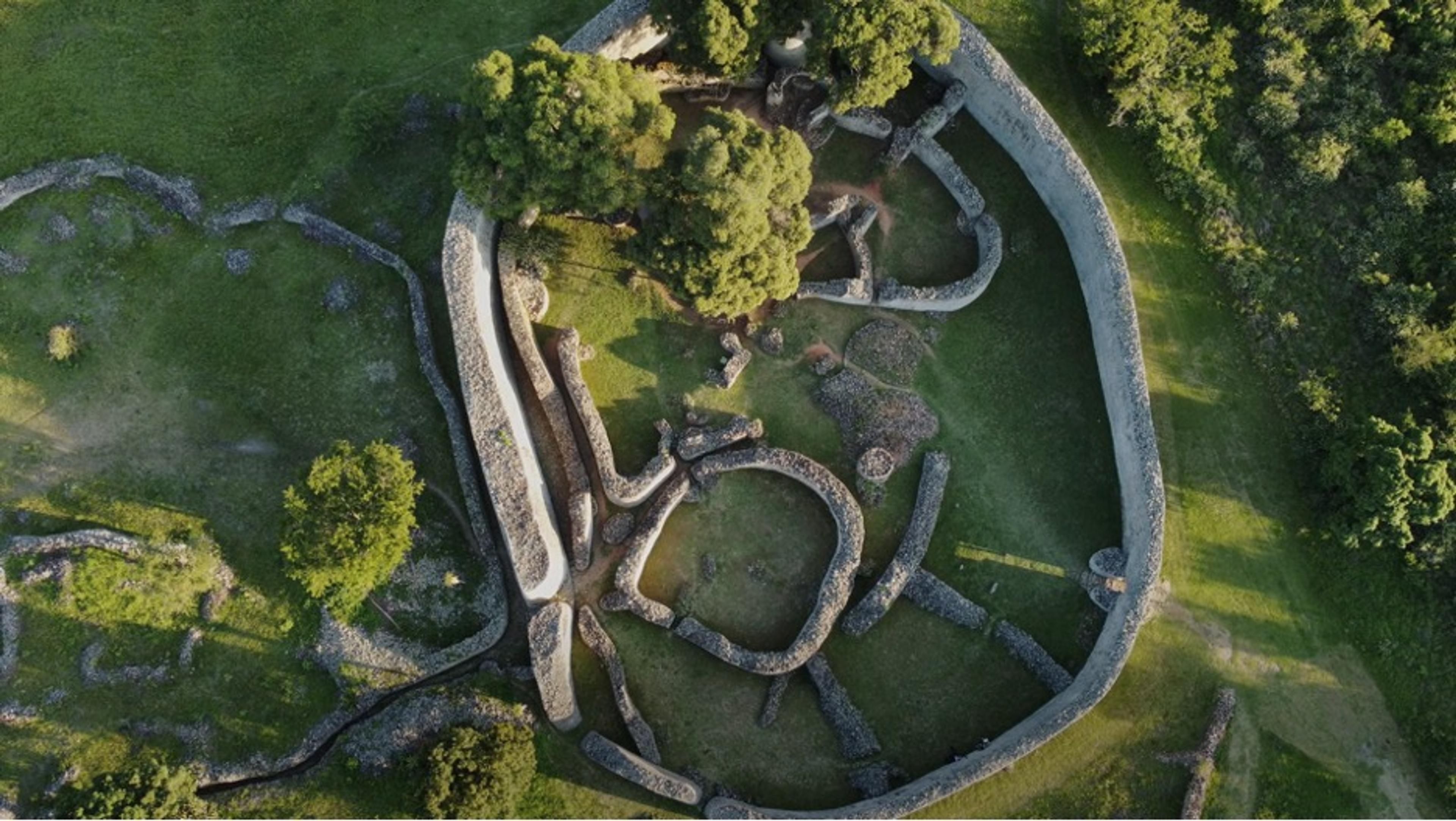The archaeological site of Great Zimbabwe is an extensive remnant of a dry-stone walled ancient African city occupied between the eleventh and seventeenth centuries. The site was the capital of the Zimbabwe state, which exerted its influence over much of the Zimbabwean plateau. The central and built-up area of the site covers approximately 80 hectares, making Great Zimbabwe the largest of more than 500 stone-walled sites scattered across the present-day countries of Zimbabwe, Botswana, Mozambique, and South Africa. At its peak, the city housed a population of around 20,000 people, whose economic life revolved around such activities as animal husbandry, crop cultivation, weaving, iron smelting, copper and gold working, and the trade of gold and ivory on the coast of the Indian Ocean. Great Zimbabwe was the heart of a thriving empire that inspired the economies of other settlements across southern Africa.

Map of Zimbabwe showing the locations of Great Zimbabwe and other stone-walled sites
The site has three main areas: the Hill Complex, the Great Enclosure, and the Valley Enclosures. These are characterized by dry-stone walled construction but also include dhaka (adobe) structures. The dry-stone walls were constructed from granite blocks gathered from the exposed rock of the surrounding hills. Since this rock naturally splits into even slabs and can be broken into portable sizes, it provided a convenient and readily available building resource. The Hill Complex consists of freestanding walls forming enclosures on the hill summit, while the slopes are terraced on the western and southern ends to create habitation spaces. The Hill Complex can be accessed from the south via a route now referred to as the “ancient path” and from the west via the “watergate path.” Below the Hill Complex is a valley, which has a cluster of enclosures of varying sizes known as the Valley Enclosures.

Dry-stone walls at Great Zimbabwe, courtesy of Sosena Solomon
To the south is the Great Enclosure, a stunning architectural marvel that is the single largest precolonial built structure in sub-Saharan Africa. The circular outer wall has a circumference of approximately 252 meters and a maximum height of 11 meters; it also exhibits the best construction technique at Great Zimbabwe, characterized by rectangular blocks laid in relatively even and level courses. The sizes of the blocks are consistent with those in other parts of the site. The walls have a wide base of up to six meters and taper to an apex width of three meters. The outer wall of the Great Enclosure encircles a number of smaller enclosures, house floor remains, and an enigmatic structure known as the Conical Tower; the outer wall also forms a parallel passage with an inner wall from the northeastern entrance to the Conical Tower.

Aerial view of the Great Enclosure at Great Zimbabwe, courtesy of Sosena Solomon
In addition to the walled areas, Great Zimbabwe also comprises sites of spiritual and religious significance, such as the Chisikana Spring, the Mujejeje (the ritual entrance), and several sacred hills. The Chisikana Spring is at the head of the Chisikana Stream, which once flowed into the Musahagashe River now covered by Lake Mutirikwi. The spring is considered sacred by local communities owing to its association with their foundation myths. Physically, the Mujejeje is a linear-intrusive vein of quartz exposed on a granite outcrop, making a narrow bar ridge. It is 7.8 meters long and 6 centimeters wide. This geological manifestation was expropriated by the locals as a control point for visitors entering and exiting Great Zimbabwe.
Archaeological research has resulted in the recovery of numerous objects associated with the site’s settlement, and these have aided in the reconstruction of the settlement’s history and organization. Such artifacts include local pottery, imported ceramics, soapstone carvings, glass beads, gold foil, ceramic discs used as weights in the spinning of cotton, and remains of animal bone. The site’s architectural layout and material culture have been key in the reconstruction of the settlement history and the understanding of Great Zimbabwe’s economic, social, and political organization. Radiocarbon dates and imported materials such as glass beads and porcelain suggest that the site was occupied between the eleventh and seventeenth centuries.
The most famous and iconic works associated with Great Zimbabwe are eight carved soapstone birds, commonly referred to as the Zimbabwe birds, that were found within the site. The birds surmount columns more than a meter tall and are themselves on average 40 centimeters tall. The sculptures combine human and avian elements, with human features like lips substituting for beaks and five-toed feet for claws. Six of the sculptures came from the Eastern Enclosure of the Hill Complex. One was recovered in the Western Enclosure, and another from inside the Central Valley ruins of the Valley Enclosures. Scholars have suggested that the birds served as status and religious symbols and are emblematic of royal authority. In addition to the birds, other soapstone objects recovered at the site include pendants, embellished columns, smoking pipes, ingot molds, figurines, and bowls adorned with different animals and other motifs. Archaeological evidence dates the earliest production of both utilitarian and nonutilitarian soapstone creations to earlier than the eleventh century. The deep history of soapstone carving at Great Zimbabwe inspired a network of twentieth-century sculptors, including Henry Munyardzi and Sylvester Mubayi, to produce works in the same medium (2024.81.1; 2024.81.2; 2024.81.3; 2024.81.4; 2024.81.5; 2024.81.6).
The economic life of the capital has been reconstructed from the multiple objects and ethnographies associated with the site. The recovery of faunal remains attest to the importance of both domesticated and wild animals in the economy of the state. Cattle, in particular, were a key source of wealth and could also be used as draft power in the cultivation of crops. Other domestic livestock included goats and sheep. In addition to being a source of nutrition, wild animals were exploited for their skins, ivory, and use as trophies, all of which could be exchanged with traders. Crop cultivation was equally important, and archaeological research has led to the recovery of charred sorghum, evidence of that cereal’s presence at Great Zimbabwe. Other crops that were cultivated include pearl millet and finger millet.
The smelting of metals such as iron and copper at Great Zimbabwe is demonstrated by the presence of ores, slags, and tuyeres from as early as the fifth century. Multiple crucibles recovered from the site were used to melt gold, copper, bronze, and brass. Metal production resulted in the manufacture of both utilitarian and decorative objects. Some of the utilitarian objects include spears, hoes, arrowheads, and axes. Decorative items include bangle heads and bracelets made from different metals. The presence of exploitable sources of iron, copper, and gold within a variable distance of the site was also a key factor in the development of the metal industry at Great Zimbabwe.
The material culture described thus far does not include works made from wood primarily because that medium is susceptible to decay and doesn’t survive well in the archaeological record. However, nineteenth- and twentieth-century objects preserved in museums such as The Met and similar objects still in use in descendant communities of the Shona peoples offer a sense of the range of carved wooden creations that might have been used at the site. The Met collection includes several examples of nineteenth- and twentieth-century wooden headrests from Zimbabwe related to those that were likely in use at Great Zimbabwe ; ; . The headrests were hand-carved from indigenous wood and often have a shell disk design known as ndoro, which is believed to be connected to one’s spirit. The headrest is thought to hold spiritual power and invoke dreams. The practice of sheathing headrests with metal, particularly gold, was common in the region and was most likely associated with the elites at Great Zimbabwe. Other utilitarian objects such as hoes, axes ; , spears, and other tools ordinarily had wooden handles, though only the metal component is recovered from the archaeological record.
Analyzing these material and architectural remains gives us an incredibly complex picture of the development of Great Zimbabwe. First settled in the eleventh century, it rose to economic prominence between the twelfth and fifteenth centuries. During that time, it commanded trade networks that extended from the Zimbabwe Plateau to the Indian Ocean and offered residents access to imported items in the form of glass beads and glazed ceramics. That trade economy complemented thriving local industries that included soapstone carving, metal smelting, and animal husbandry. The influence of Great Zimbabwe began to decline in the late fifteenth century in favor of the increasingly powerful Khami state to the southwest.
While a great deal of information has been generated about Great Zimbabwe from past research, significant gaps remain that contemporary scholars seek to fill. Current excavations at the site, led by Shadreck Chirikure from the University of Oxford, aim to apply archaeological sciences to answer some of the pertinent questions about the lifeways of the people at Great Zimbabwe. These include refining our understanding of the plant economy and craft production techniques and processing. Scholars are also focusing on Great Zimbabwe’s hinterland as an important step toward understanding local and regional networks in the wider region of southern Africa. The application of local Shona concepts that had hitherto been largely ignored in the interpretation of Great Zimbabwe is also important in any attempt to understand the site.